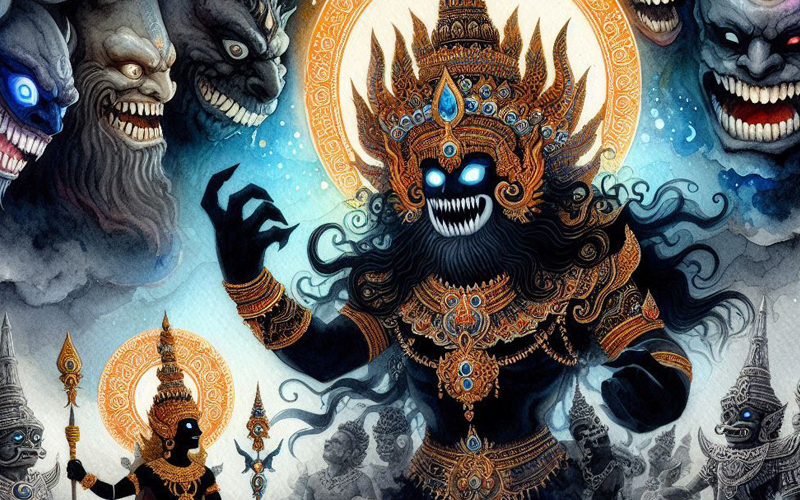Physical Address
Empirical System, 105 First Floor Pitru Krupa, Opp. R.K. Desai College, Koparli Road, Vapi (Gujarat) 396 191
Physical Address
Empirical System, 105 First Floor Pitru Krupa, Opp. R.K. Desai College, Koparli Road, Vapi (Gujarat) 396 191

After the Mahabharata War, Lord Krishna continued to rule in Dvaraka.
However, his departure from the Earth marked the end of Dvapara Yuga and the beginning of Kali Yuga.
The Pandavas ruled for a few decades before renouncing the world.
They entrusted the throne to Arjuna’s grandson, Parikshit.
Parikshit was a wise and just king who maintained peace and righteousness in his kingdom.
Even though Kali Yuga technically started with Krishna’s death, its full influence was delayed because of the reign of King Parikshit.
One day, Parikshit saw a disturbing sight.
A man dressed like a king was mercilessly beating a bull and a cow.
The bull represented Dharma (righteousness), which in previous ages stood on four legs, but in Kali Yuga, it stood only on one leg, symbolizing the decline of righteousness.
The cow symbolized Bhakti (devotion), also suffering under the influence of Kali.
Seeing this act of cruelty, King Parikshit was enraged and confronted the man, who revealed himself to be Kali, the spirit of the age of darkness.
Parikshit prepared to kill Kali, but Kali, realizing he was no match for the righteous king, surrendered and begged for his life.
Kali pleaded for a place to reside, arguing that his role in the cosmic order was also sanctioned by divine will.
Reluctantly, King Parikshit granted Kali a few places where he could reside:
1. Gambling and betting – Places of deceit and dishonesty.
2. Drinking alcohol and intoxicants – Places where people lose self-control and indulge in vices.
3. Relations with immoral women – Places of moral decay and loss of family values.
4. Animal slaughter – Places of violence and cruelty.
5. Gold – Representing greed and materialism.
By granting these places, Parikshit restricted the influence of Kali Yuga but acknowledged its inevitability.
Despite these restrictions, Kali found a way to influence King Parikshit by residing in his golden crown.
This influence led Parikshit to commit a disrespectful act.
One day, tired and thirsty after an expedition, he entered the hermitage of the sage Samika, who was in deep meditation.
Unable to get a response from the sage, Parikshit, in a moment of weakness and anger, placed a dead snake around the sage’s neck as a form of insult.
When the sage’s son, Shringi, learned about this insult, he cursed Parikshit to die from the snake king Takshaka’s bite within seven days.
When Samika finally came out of his meditation, he noticed the dead snake around his neck and was distressed.
Upon learning about his son Shringi’s curse on the king, Samika was deeply troubled. Sage Samika explained to Shringi that cursing the king was a grave mistake.
He told his son that King Parikshit was a righteous ruler and his actions were out of character.
Understanding the severity of the situation, Sage Samika instructed his son to go to King Parikshit and inform him about the curse.
He wanted Parikshit to know about his impending death so that the king could make the necessary preparations.
Shringi, respecting his father’s wisdom, went to King Parikshit’s court and conveyed the message of the curse.
He informed the king that due to his disrespectful act, he was cursed to die by the snake king Takshaka’s bite within seven days.
King Parikshit, upon hearing about the curse, did not react with anger or retaliation.
Instead, he accepted the curse as a consequence of his actions.
He understood that the sage’s son acted out of youthful anger and that the curse was part of the divine plan.
Parikshit accepted his fate calmly.
Acknowledging his fate, Parikshit prepared for his death.
He crowned his son, Janamejaya, as the new king and advised him not to wear a golden crown but a royal turban to avoid Kali’s influence.
Parikshit then renounced his royal duties and spent his remaining days on the banks of the Ganges, listening to the Srimad Bhagavatam, a sacred scripture narrated by the sage Shuka, son of Sage Vyasa.
Janamejaya, Parikshit’s son, performed a snake sacrifice to ensure that the snake Takshaka would not be alive to take his father’s life and to avoid his father’s death.
However, he eventually realized the futility of revenge and accepted the cosmic order, understanding that Kali Yuga’s influence was inevitable.
On the seventh day, as predicted, King Parikshit was bitten by the snake king Takshaka and died.
His death marked the firm establishment of Kali Yuga, an era characterized by a decline in moral and spiritual values.
Thus, King Parikshit’s actions and the curse he received played a crucial role in the establishment of Kali Yuga, signifying the transition to an era characterized by a decline in righteousness and the rise of moral and spiritual decay.